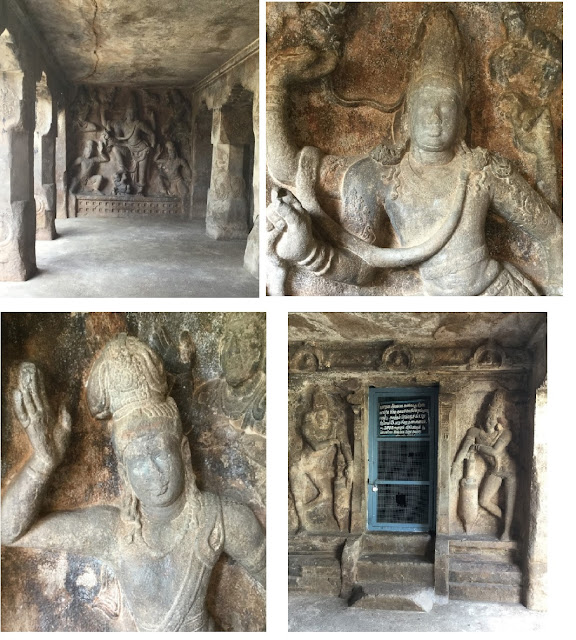Rock Cut shrines of The Trichy Rock
The most recognisable landmark of Tirucchirapally is the massive rock outcrop , rising to a height of 83 meters from the flat land all around. Bald and smooth , this rock formation is believed to be among the oldest in the continent , older perhaps than the Himalayas , and rich in quartz and feldspar .
The Rock is generally referred to as "Malai Kottai" , in conjunction with the Fort ( Kottai) built upon it by the Madurai Nayaka , Vishwanatha of 16th Century . But it was not as though the Nayakas were the first to find a use for The Rock . Before them, the Pallavas, with their fondness for rock cutting technology, had tried their hand at making rock-cut shrines here. However , the Ganapathi temple at the summit was left unfinished by them , to be developed by the Nayakas later into the very famous Ucchi Pillaiyar Temple .
The Pallava Cave
But the Pallavas did finish one cave shrine on the southern face of The Rock, just a little above base, naming it Lalithankura Pallaveshvara Griham . It can be seen today on the way up from Thayumanavar Temple to Ucchi Pillaiyar . It is generally kept locked up with grill gate by ASI , which protects it ,but the ASI Guard will open it for anyone who is interested in it. Though good number of people do visit the other two living temples of The Rock , very few take the trouble to look in or even notice it.
It is just one hall with the beautiful four sided pillars , with a cell guarded by two dwarapalakas on one side and the most beautifully executed Gangadhara panel on the other side . The back wall was left bare , on which an inscription of later times has been inscribed.
The Gangadhara panel , verily a masterpiece , is analysed by scholars to be a self -glorifying analogy commissioned by Mahendravarman I . Likening his advent into Kaveri region , held by Pandyas and Cholas , to the triumphant act of Shiva arresting the powerful flood of Ganga . The four armed Gangadhara is Style personified , standing in tribhanga, holding out that one strand of his jata to let Ganga trickle down ; one leg resting on the head of a gana. A small form, Ganga, is entering his Jata on top. All around him are adoring figures : Two flying Vidhyadharas and two kneeling devotees , of which one is thought to be Mahendra himself. Rishis seen in the background.
The one figure that has mystified one and all , is the animal above Shiva's raised left hand. Is that the Deer ? Unlikely ! It crouches more like a ....dog ? Most unlikely animal to be seen above Shiva's hand .
Scholars and enthusiasts spend their spare time rustling up theories about this mysterious animal and the greater mystery of whether Mahendra projected himself in this Gangadhara!
However that might be , artistically , it is a very beautiful piece of sculpture indeed. Salutations to those early sculptors. And the Pallava Grantha calligraphy seen on the pillars is an artwork in itself.
The Pandya Cave
The other rock cut shrine is more straight forward in its intent , offering no puzzles for us to solve . Generally called " The Lower Cave" , it is situated at the base of The Rock , at the end of a narrow side lane that passes through a locality of small houses .
This is a majestic Rock Cut , with a wide pillared facade has a large hall with two lateral shrines .A long line of chubby , frolicking Ganas form a garland on the lintel. The interior wall is adorned with a whole pantheon of deities, each standing within a frame , with celestials in attendance . There are Dwarapalas stationed by every doorway and frame.
This cave was excavated by Pandyas of 8 CE.. The deities have well built physique and the limited ornamentation , but exude a powerful majesty in bearing, though many portions of the cave are unfinished .
The devatas represented here are : Ganesha , Kartikeya, Brahma, Surya and Kottravai (Durga) . A devotees of Kottravai is seen offering his heads as sacrifice . Vishnu is seen in one of the lateral cells ( locked) , and it can be assumed that the other later cell , opposite it, would have had a Shiva/ lingam , thus completing the set .
The large open ground in front of the cave is used by local youngsters to play cricket. The noisy, bouncing children make an adorable contrast against the hoary cave with its beautiful, silent denizens.
Both Caves are ASI Protected Monuments.





Comments